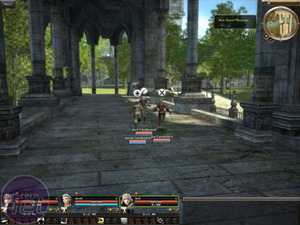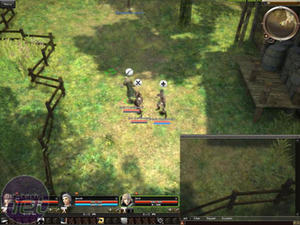
Granado Espada? WTF?
The merchant ship at the very start functions as a quick tutorial, running up and down the deck doing a simple fetch quest and getting used to the controls. The interface is the usual run of the mill stuff – moveable windows and toolbars which grant access to the various stats and equipment pages. The very nature of an interface like this means it is hard to criticise as all the windows and pages can simply be shifted about as wanted.However, one thing which did bug us was the chat pane, which by default occupied a large portion of the lower right screen. Not a problem initially, resizing it down and then dragging it out of view was enough of a solution for us when we were too busy screen-capturing to be sociable, but shifting from one area to another would set it back to default and we’d have to resize and shrink it again. Not crippling, but a persistent annoyance.
Being dumped off of the merchant ship opens up a bit more of the gaming world and it exploration entices the players on. By this stage it was possible for us to expand our family – a process which usually involves a lot of nudging and winking, but which here is limited to creating two more characters which will follow the lead character.
The extra characters available certainly help make Granado Espada feel a little more collaborative and open to different styles and it becomes a lot easier to execute some advanced tactics without having your plans ruined by some Leeroy Jenkins wannabe. Taking a small team of three family members in this case Joe, Jacob and Jack Cardboard also allows players a greater amount of versatility than a singleplayer, single character game, which is always good.
A player's family are quickly given another set of fetch quests and simple tasks to complete – get this antique appraised, get this document signed, etc. – but the quests quickly build up into more complex and interesting variants and before we knew it the Cardboard family was being destroyed in any number of dungeons as we plunged recklessly into battle because, to be honest we are Leeroy Jenkins wannabes.
The gaming areas themselves are just like the characters which play in them, which is either a very good or bad thing depending on how you look at it. On the good side, the graphics on the environments are just as detailed as the character graphics, though a little bland on the whole. Nothing in particular stands out as being stunningly realised but there is a good amount of detail in everything, which is handy for when the camera launches in for an automatic close-up when players chat with NPCs.
Game mechanics too are fairly rudimentary – characters have the standard selection of skills, as well as stances which can give extra defensive and offensive bonuses. Having chosen a fighter, a scout and a musketeer in our family in order to gain the benefits of range, speed and aggression we were able to have a look at a lot of the different skills available and none of them sprung out as incredibly inventive or inspirational. Not that they were bad, or hard to use, just that they weren’t particularly great.
We started to notice this was a recurring theme in Granada Espada, which is the name of the land players get a chance to explore and is named after the two explorers who discovered it. While none of the features were bad, per se, none of them were strikingly brilliant. Nothing about the game seems to be stupidly done, but nothing really stands out as being incredibly fantastic and there isn’t any real killer feature, other than the freebie status of the game which suddenly starts to make sense.
It is, in essence, the MMO equivalent of paint by numbers. The end result is far above the type of childish scribble that most free games fall into, but not really up there with the heavyweight MMO games like World of Warcraft or Lord of The Rings: Online.

MSI MPG Velox 100R Chassis Review
October 14 2021 | 15:04













Want to comment? Please log in.